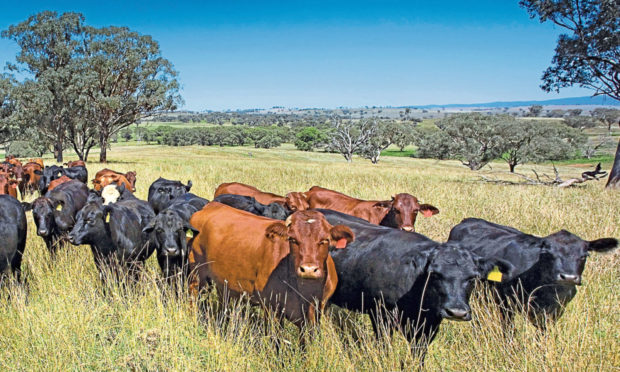While UK agriculture has been worrying about the prospect of a carbon tax on beef arising from the sector’s greenhouse gas emissions, on the other side of the globe an Australian farmer is laughing all the way to the bank having demonstrated that his cattle achieve the exact opposite.
Wilmot Cattle Co from New South Wales have been paid $500,000 (£279,000) by Microsoft for 40,000 tonnes of carbon credits in the form of soil carbon sequestered on their holdings over the last few years, achieved by the rotational mob grazing of cattle.
It is a case of “the right cow in the right place” grazing “the right grass in the right place” which shows that livestock under appropriate management are a solution to climate change and not the problem.
Wilmot have embraced regenerative farming using all we know about rotational livestock grazing on swards made up of diverse species.
The grazing management has boosted their productivity but also resulted in soil carbon increasing from 2.5% to 4.5% and they aim to reach 6% by 2023, which will no doubt result in further income for carbon credits.
Australian farmers have been successful in making the argument that farming can offer a unique solution to climate change: It is the only realistic means we have at present to put carbon back into the soil.
They have accepted that in the past they made some big environmental mistakes, but by focusing on soil carbon and demonstrating what farmers can achieve using new methods, they have won public support and the Australian Government has put emphasis on soil carbon as a major part of the country’s decarbonisation strategy.
Australian farmers are making the most of it. No longer considered in the same category as witchcraft, regenerative farming principles are supported by their soil scientists and in some areas have now been adopted by 90% of farmers.
It is a climate-mitigating argument that is yet to be made and won by Scottish agriculture, and there is a danger we will continue to miss out on the rewards.
The distribution of rural funds announced by the Scottish Government last autumn clearly suggests farming, in contrast to forestry, has failed to make a strong case to the public that agriculture can provide a solution to climate change.
Of the £160 million rural investment for forestry and agriculture, £150m went to forestry, leaving only £10m to agriculture.
Farming’s carbon argument has not been heard – possibly our industry’s greatest failing of recent years.
Yet by adopting the right farming techniques, agriculture has a greater potential than forestry to mitigate climate change.
Recent research by Teagasc in Ireland found a level of soil carbon across 10 grassland farms of 346 tonnes per hectare, with an estimated potential to sequester further soil carbon of 792 tonnes per hectare. That is 10 times the carbon sequestered in a mixed age sitka spruce plantation.
As the Wilmot Cattle Co has shown, farming can make a big contribution to climate mitigation and reap the rewards.
Across the UK we have examples of farmers in most sectors who can demonstrate that their farming methods sequester carbon at a faster rate than commercial forestry.
All that is missing is recognition and support from Scottish agriculture’s representatives, scientists and researchers, without which farming’s carbon argument will struggle to be heard.
- Christopher Nicholson is chairman of the Scottish Tenant Farmers’ Association. He farms at Kidsdale Farm, Whithorn, Wigtownshire.










